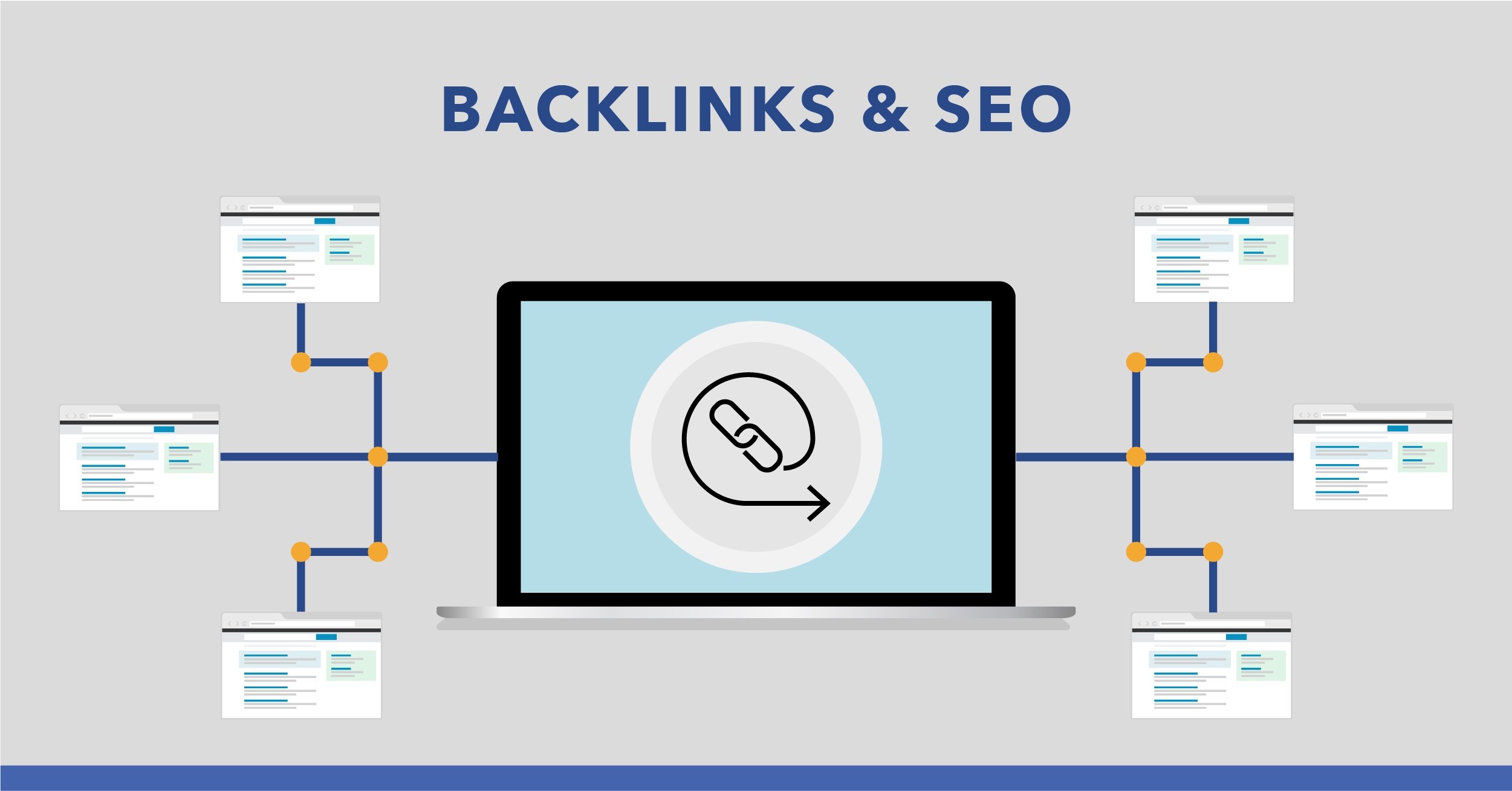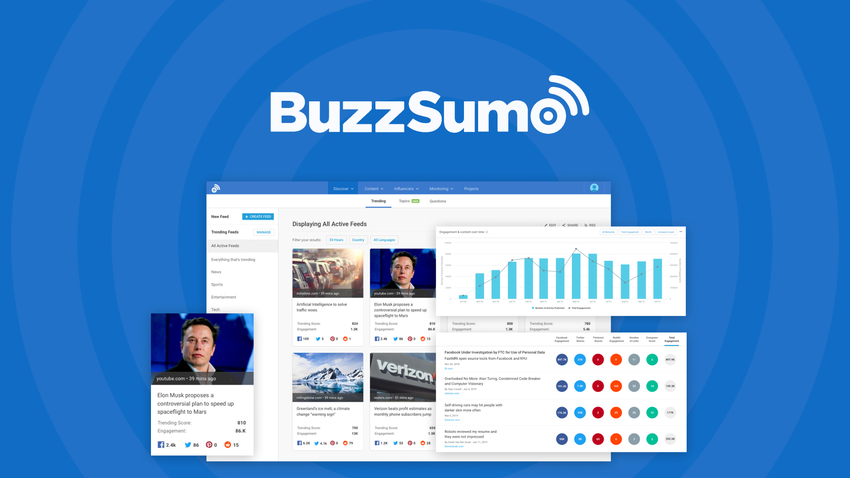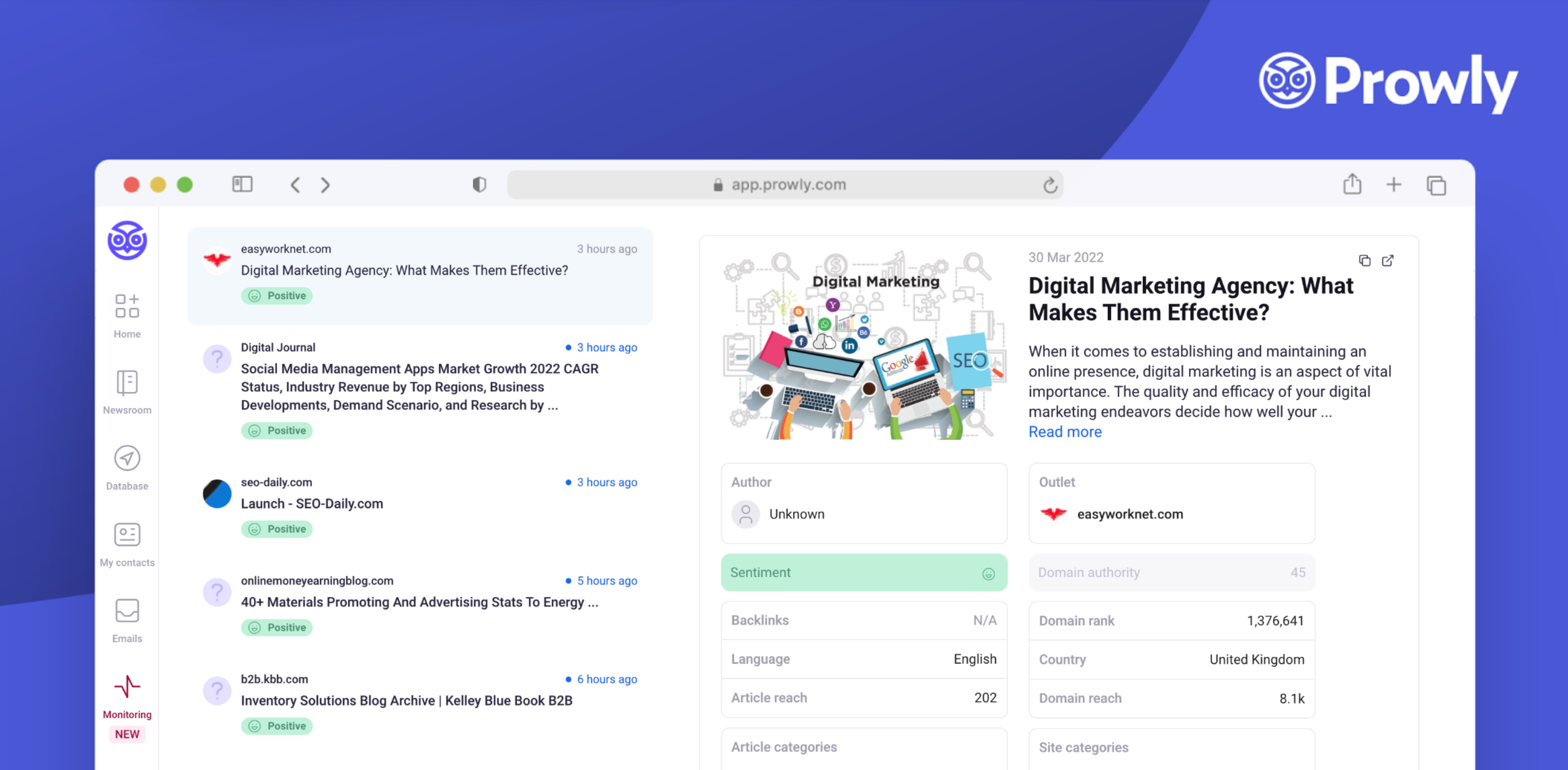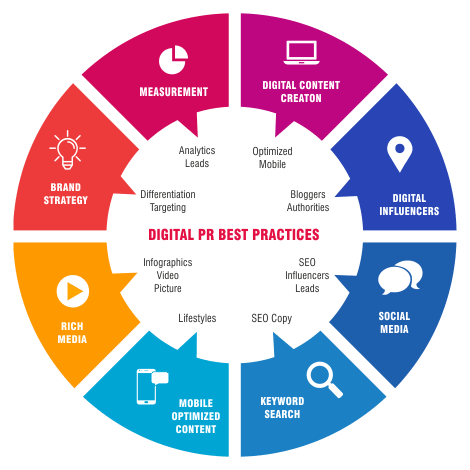Part 1: Understanding Digital PR and Its Importance
1.1 What is Digital PR?
Digital PR is a modern take on public relations, focusing on gaining online coverage through digital platforms, including blogs, podcasts, and social media. Unlike traditional PR, which often relies on print media and broadcast channels, digital PR emphasizes online interactions to enhance visibility and build brand credibility.
In a world where consumers increasingly rely on the internet for information, digital PR has become essential for brands seeking to establish their presence in the digital landscape. It involves creating compelling content, engaging with journalists and influencers, and leveraging various online platforms to achieve marketing goals.
Key Components of Digital PR:
- Content Creation: Developing shareable content that resonates with target audiences.
- Media Engagement: Building relationships with journalists and influencers to secure coverage.
- Online Reputation Management: Monitoring and managing your brand’s online presence.
1.2 The Importance of Backlinks in SEO
Backlinks, also known as inbound links or incoming links, are links from other websites that point to your site. They serve as a vote of confidence from one site to another, signaling to search engines that your content is credible, valuable, and relevant.

Why Are Backlinks Important?
- Search Engine Rankings: Backlinks are one of the top ranking factors in search algorithms, meaning that the more high-quality backlinks you have, the better your site may rank in search engine results pages (SERPs).
- Referral Traffic: Backlinks can drive direct traffic to your website. When users click on a link from another reputable site, they are directed to your page, increasing the likelihood of conversions.
- Brand Authority: Having backlinks from reputable sources enhances your brand’s authority and credibility within your industry.
1.3 Why Digital PR is Essential for Building Backlinks
Digital PR serves as a vital tool for building backlinks for several reasons:
1.3.1 Enhanced Credibility and Authority
Securing backlinks from high-authority websites boosts your domain authority and establishes trust among users and search engines. When a reputable site links to your content, it indicates that your information is reliable and worth sharing.
1.3.2 Increased Brand Awareness
Digital PR helps raise your brand’s profile by getting your name out there through media coverage. As more people become aware of your brand, they may search for it online, leading to an increase in organic traffic.
1.3.3 High-Quality Content Creation
Digital PR encourages the creation of high-quality, engaging content that can attract backlinks naturally. By focusing on valuable content that resonates with your target audience, you increase the chances of being referenced by other sites.
1.4 Common Misconceptions About Digital PR
Despite its importance, many businesses hold misconceptions about digital PR that prevent them from effectively implementing it.
1.4.1 Myth of Exclusivity
One common misconception is that digital PR is only accessible to large agencies or established brands. In reality, small businesses can leverage digital PR strategies effectively by utilizing available resources, tools, and creativity.
1.4.2 Fear of Complexity
Many companies assume that executing a successful digital PR campaign requires extensive resources or complicated processes. However, with the right approach and tools, even small teams can launch effective campaigns.
1.5 Real-World Examples of Successful Digital PR Campaigns
To illustrate the effectiveness of digital PR in building backlinks, let’s explore a few real-world examples:
1.5.1 Writer Buddy AI Campaign
Writer Buddy AI executed a successful digital PR campaign by creating an analysis of the most visited AI tools on the market. This campaign tapped into the growing interest in artificial intelligence (AI) and generated significant media coverage.
By providing valuable insights and an engaging infographic that visualized their findings, Writer Buddy AI secured numerous backlinks from reputable sites. Their ability to align their content with current trends made it a hit among journalists looking for fresh stories.
1.5.2 Crossword Solver Emoji Campaign
In another example, Crossword Solver conducted a data analysis on the most popular emojis used on Twitter across various countries. The company identified a unique angle that resonated with audiences and journalists alike.
By comparing emoji usage in different regions and presenting the findings in an engaging format, Crossword Solver attracted significant media attention, resulting in multiple backlinks from various publications.
1.5.3 Signs.com Logo Survey
Signs.com conducted a creative campaign where they surveyed individuals to recreate logos of popular brands like Apple and Burger King. The quirky nature of this project fascinated audiences and encouraged social sharing.
The resulting article showcased hilarious interpretations of well-known logos and became highly shareable content. As a result, Signs.com garnered hundreds of backlinks from different media outlets seeking lighthearted stories.
Wrapping up Part 1
Understanding digital PR is crucial for any business looking to build backlinks effectively. By grasping its importance in enhancing credibility, authority, and brand awareness, companies can leverage digital PR strategies to create high-quality content that attracts valuable backlinks.
In the next part of this guide, we will delve into crafting a comprehensive digital PR strategy that outlines practical steps you can take to execute successful campaigns aimed at acquiring backlinks to your website. Stay tuned as we explore how to identify goals, choose the right campaign types, and utilize tools that will enhance your digital PR efforts!
Part 2: Crafting Your Digital PR Strategy
Building digital PR backlinks requires a well-thought-out strategy that aligns with your brand’s goals and resonates with your target audience. In this part, we will discuss how to identify your goals, explore different types of digital PR campaigns, utilize essential tools, build an effective media list, and craft compelling pitches that attract attention.
2.1 Identifying Your Goals
Before launching a digital PR campaign, it is crucial to define your objectives. Understanding what you want to achieve will guide your strategy and help measure success. Here are some common goals for digital PR campaigns:
2.1.1 Define Objectives
- Increase Brand Awareness: If your primary goal is to get your brand name out to a wider audience, focus on campaigns that promote unique aspects of your business or industry.
- Drive Website Traffic: If you want to boost traffic to your website, create content that encourages users to click through to your site for more information.
- Improve SEO Ranking: If enhancing your search engine rankings is the goal, focus on acquiring high-quality backlinks from authoritative sites.
2.1.2 Target Audience
Understanding your audience is essential for tailoring your content and outreach efforts. Ask yourself:
- Who are my ideal customers?
- What kind of content do they consume?
- Which publications or influencers do they follow?
By identifying your target audience, you can create content that speaks directly to their interests and needs.
2.2 Types of Digital PR Campaigns
Choosing the right type of campaign can significantly impact the success of your digital PR efforts. Below are three primary types of digital PR campaigns:
2.2.1 Content-First Approach
This approach focuses on creating valuable and engaging content that addresses current trends or topics relevant to your audience.
Example: Signs.com Campaign
Signs.com executed a campaign in which they surveyed individuals to recreate logos of popular brands. By presenting funny and creative interpretations of well-known logos, the campaign generated significant media interest and backlinks from various publications.
Tips for a Content-First Approach
- Identify trending topics in your industry using tools like Google Trends or BuzzSumo.
- Create visually appealing infographics, videos, or articles that offer valuable insights or entertainment.
- Ensure your content is shareable and easy to understand.
2.2.2 Newsjacking
Newsjacking involves capitalizing on current events or trending news stories by creating relevant content quickly.
Example: Bulk.com Campaign

When Chris Martin from Coldplay made headlines for his intermittent fasting, Bulk.com quickly reached out to journalists who had covered the story. They provided expert opinions from nutritionists explaining the potential downsides of such a diet, which led to significant media coverage.
Tips for Newsjacking
- Monitor news sources and social media for trending topics relevant to your industry.
- Be prepared to create content related to these stories quickly.
- Provide valuable insights or expert opinions that journalists can use in their articles.
2.2.3 Proactive Campaigns
These campaigns anticipate predictable events, such as holidays or seasonal trends, creating relevant content ahead of time.
Example: CreditFix Christmas Lights Campaign
CreditFix created a Christmas lights electricity cost calculator ahead of the holiday season. By addressing concerns about energy costs during a time when many people decorate their homes, the campaign attracted media attention and backlinks.
Tips for Proactive Campaigns
- Use a calendar to plan campaigns around predictable events throughout the year.
- Create engaging content that answers common questions or concerns related to these events.
- Utilize interactive elements (like calculators or quizzes) to enhance engagement.
2.3 Tools for Effective Digital PR Campaigns
Several tools can streamline your digital PR efforts, helping you research topics, identify influencers, and manage outreach.
2.3.1 Research Tools
- BuzzSumo: This tool allows you to identify trending topics and analyze the performance of content in your niche. You can see what types of content are getting the most shares and engagement.
- Google Trends: A valuable resource for understanding what people are currently searching for. It can help you identify seasonal trends and popular topics in real time.

2.3.2 Outreach Tools
- Prowly: A comprehensive public relations management tool that helps you build media lists, send press releases, and track coverage.
- Journal Finder: This tool helps you find journalists in your industry and manage outreach efforts efficiently.

2.4 Building Your Media List
Creating an effective media list is essential for successful outreach. Here are steps to building a robust media list:
2.4.1 Identifying Relevant Journalists
Use tools like Cision or Media Contacts to find journalists who cover topics related to your industry or niche. Look for those who have written about similar subjects in the past.
2.4.2 Segmenting Your List
Once you have identified potential journalists, categorize them based on:
- Publication: Group by the media outlet they write for.
- Audience: Identify their target demographic (e.g., tech enthusiasts, lifestyle readers).
- Relevance: Assess how closely their coverage aligns with your campaign themes.
2.5 Crafting Your Pitch
An effective pitch is crucial for capturing journalists’ attention and securing coverage. Here are key elements to consider:
2.5.1 Elements of a Successful Pitch
- Personalization: Tailor your message to each journalist’s interests and previous work. Mention specific pieces they have written to show you have done your homework.
- Clarity and Brevity: Keep your pitch concise—aim for a few short paragraphs that get straight to the point without unnecessary fluff.
2.5.2 Example Pitch Structure
- Introduction: Briefly introduce yourself and your brand.
- Example: “Hi [Journalist’s Name], I’m [Your Name] from [Your Company]. We specialize in [Your Area of Expertise].”
- Value Proposition: Highlight what makes your story unique and newsworthy.
- Example: “I wanted to share our latest research on [Specific Topic] that uncovers surprising insights about [Key Findings].”
- Call to Action: Encourage them to reach out for more information or further discussion.
- Example: “If you’re interested, I’d be happy to provide more details or answer any questions you may have.”
Wrapping up Part 2
Crafting a strategic digital PR approach involves clearly defining goals, choosing the right type of campaigns, utilizing effective tools, building a targeted media list, and crafting compelling pitches that engage journalists. By following these guidelines, you can create successful digital PR campaigns that generate valuable backlinks to your website.
In the next part of this guide, we will explore how to execute your digital PR campaign effectively, from launching outreach efforts to analyzing results and refining future strategies. Stay tuned as we delve deeper into the practical aspects of building digital PR backlinks!
Part 3: Executing Your Digital PR Campaign
Now that you have a solid understanding of digital PR and have crafted your strategy, it’s time to execute your campaign. In this section, we will discuss how to launch your campaign effectively, monitor responses, analyze results, and implement best practices for ongoing digital PR efforts. We will also cover future trends in digital PR that you should keep an eye on.
3.1 Launching Your Campaign

3.1.1 Timing Your Outreach
The timing of your outreach is crucial for the success of your digital PR campaign. Consider the following factors when planning your outreach schedule:
- Industry Events: Align your campaigns with relevant industry events or conferences to maximize interest and engagement.
- Seasonal Trends: Factor in seasonal changes or holidays that may affect your audience’s interests and behaviors.
- News Cycles: Stay updated on current events that could impact your industry, allowing you to capitalize on trending topics.
Example: Aligning with Events
If you’re running a campaign about eco-friendly products, consider launching it around Earth Day. This alignment can enhance visibility as media outlets look for related stories during that period.
3.1.2 Monitoring Responses
Once your campaign is live and outreach has begun, it’s essential to monitor responses from journalists and media outlets. Here are some ways to do that:
- Email Tracking Tools: Utilize tools like HubSpot or Yesware to track open rates and engagement with your outreach emails.
- Google Alerts: Set up alerts for your brand name or specific keywords related to your campaign to stay informed about mentions in the media.
- Social Media Monitoring: Keep an eye on social media platforms for any discussions or shares related to your campaign.
3.2 Analyzing Your Results
After your campaign has run its course, analyzing the results is crucial for understanding its effectiveness and identifying areas for improvement.

3.2.1 Measuring Success
To evaluate the success of your digital PR campaign, consider tracking the following metrics:
- Backlinks Acquired: Use tools like Ahrefs or SEMrush to monitor how many backlinks were generated from your campaign and from which domains.
- Referral Traffic: Check your Google Analytics data to see how much traffic was driven to your site as a result of the campaign.
- Media Mentions: Keep a record of all articles and mentions in the media related to your campaign.
3.2.2 Tools for Analysis
Several tools can assist you in analyzing the impact of your digital PR efforts:
- Ahrefs: This tool provides insights into your backlink profile and helps you track the performance of your acquired links.
- Google Analytics: Use this tool to measure traffic sources, user behavior, and conversion rates resulting from your campaign.
- BuzzSumo: Analyze content performance and track social shares or engagement metrics for articles related to your campaign.
3.3 Case Studies of Successful Campaigns
Learning from real-world case studies can provide valuable insights into effective digital PR strategies. Here are two successful campaigns that exemplify effective digital PR link-building tactics:
3.3.1 Job Security Survey Campaign
A recent campaign focused on public sentiment regarding job security in relation to AI developments. The team conducted a survey that gathered insights from various demographics about their concerns and perceptions of AI’s impact on employment.
Execution Details:
- Survey Creation: A well-structured survey was designed to gather pertinent data.
- Targeted Outreach: The results were sent to journalists covering technology and employment issues, providing them with compelling statistics and stories.
Results:
The campaign led to links from high-profile sites such as Business Insider and Yahoo Finance, significantly boosting the brand’s authority in the tech space.
3.3.2 Side Hustle Trends Campaign
Another notable campaign involved identifying popular side hustles across different U.S. states using Google Trends data.
Execution Details:
- Data Analysis: The team analyzed search trends for various side hustles in each state.
- Interactive Content: They created an interactive map displaying the most popular side hustles by state, making it engaging for users.
Results:
This campaign attracted backlinks from numerous local news outlets and broader publications, including MarketWatch and Go Banking Rates, leading to increased web traffic and audience engagement.
3.4 Best Practices for Ongoing Digital PR Efforts
To maintain momentum in your digital PR efforts, consider implementing these best practices:

3.4.1 Building Relationships with Journalists
Establishing and nurturing relationships with journalists can yield long-term benefits for your digital PR campaigns.
- Networking Strategies: Attend industry events or webinars where journalists are present, and engage in conversations with them.
- Social Media Engagement: Follow journalists on platforms like Twitter or LinkedIn, share their content, and contribute meaningful comments on their posts.
3.4.2 Regular Content Updates
Keep producing valuable content that can be shared and linked back by media outlets.
- Content Calendar: Maintain a content calendar that outlines upcoming campaigns, blog posts, and relevant industry events.
- Evergreen Content: Create timeless content that remains relevant over time, ensuring it continues to attract attention and backlinks.
3.5 Future Trends in Digital PR
To stay ahead in the ever-evolving landscape of digital PR, keep an eye on emerging trends:

3.5.1 Emphasis on Authentic Storytelling
As audiences become more discerning, authenticity in storytelling will be paramount. Brands that share genuine narratives about their mission or values will resonate more with consumers and journalists alike.
3.5.2 Leveraging New Technologies
Emerging technologies such as artificial intelligence (AI) and machine learning are set to revolutionize digital PR strategies.
- AI-Powered Tools: Tools like ChatGPT can assist in content creation, while AI analytics can provide deeper insights into audience behavior and preferences.
- Data-Driven Insights: Utilizing big data to understand market trends and audience sentiments can lead to more effective campaigns tailored to specific demographics.
Final Thoughts

Executing a successful digital PR campaign involves careful planning, monitoring, analysis, and adaptation. By launching campaigns strategically, evaluating results, building relationships with media representatives, and staying aware of future trends, you can establish a robust digital PR presence that drives high-quality backlinks to your website.
As you implement these strategies, remember that digital PR is not just a one-time effort; it’s an ongoing process that requires continuous engagement and optimization. By remaining proactive and adaptable, you can leverage digital PR as a powerful tool for enhancing your brand’s online visibility and authority in an increasingly competitive landscape.
References
- https://ahrefs.com/blog/digital-pr/ – Digital PR: The Beginner’s Guide to Making Your Brand Unmissable
- https://linkbuilder.io/pr-backlinks/ – PR Backlinks – How to get Press Links From Journalists
- https://gofishdigital.com/blog/digital-pr-guide/ – The Ultimate Guide to Digital PR: From Brainstorming to Backlinks
